By Ana Rodriguez Soto - Florida Catholic newspaper
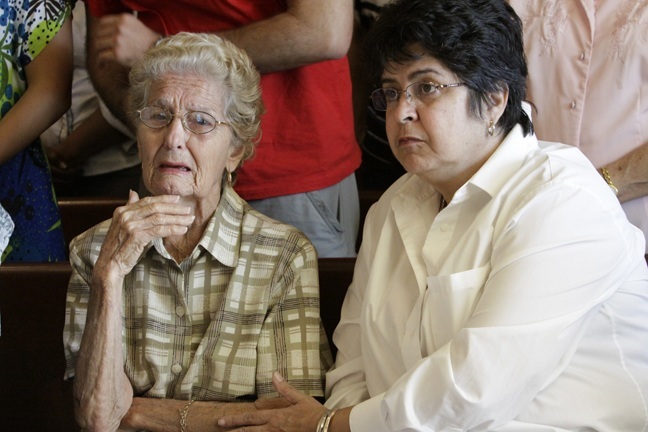
Photographer: ANA RODRIGUEZ-SOTO | FC
Zoraida Cabrera, 89, is comforted by Sulema Nieves after being overcome with emotion during the noon Mass the day after the death of Bishop Agustin Roman.
She first met Bishop Roman 30 years ago, she said. “When I arrived from Cuba, they told me, ‘Let’s go to the shrine.’ So I went to the shrine, and I kept coming here, because I loved it.”
Sitting next to her, trying to comfort her, was a friend, Sulema Nieves, the Venezuela-raised daughter of Cuban exiles. She had met Bishop Román 12 years ago.
“I came here out of desperation,” she recalled. Her mother, now 87, was gravely ill and in the hospital but she had no money to pay the bills. “He advocated on our behalf so they would help us.”
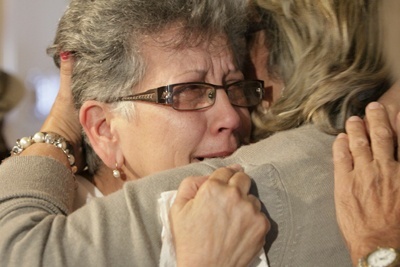
Photographer: ANA RODRIGUEZ-SOTO | FC
Emma Fernandez, a member of the Archicofradia (Guild) of Our Lady of Charity is comforted by Cristina Brito, secretary at the shrine, after viewing the body of Bishop Agustin Roman.
“He taught me to love Cubans and that is why I am here with you today,” said Father Fabio Arango, a native of Colombia who shared a home on the grounds of the shrine with Bishop Roman and several other priests.
He spoke at the same Mass April 12, a Mass that was celebrated by Msgr. Pedro Garcia, retired pastor of St. Ann Mission in Homestead. Msgr. Garcia found Bishop Roman unconscious in his car the night he died, called rescue and anointed him.
Msgr. Garcia had met Bishop Roman when he joined Acción Católica (Catholic Action), a youth group in Cuba. Bishop Roman was then a seminarian at the newly-established San Alberto Magno seminary in Matanzas province — a seminary administered by the Canadian Missionaries, and aimed at creating priests who would not wait for people to come to them, but rather go out and evangelize.
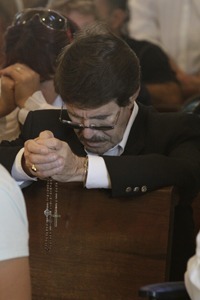
Photographer: ANA RODRIGUEZ-SOTO | FC
Faithful pray at the Shrine of Our Lady of Charity during the noon Mass the day after the death of Bishop Agustin Roman.
“It’s a natural saintliness,” said Rogelio Zelada, associate director for Hispanic formation in the Office of Lay Ministry and Adult Faith Formation.
He met Bishop Román when the latter spoke a few words at the end of a Mass in Puerto Rico in 1985. Zelada was impressed by how quickly and how simply the bishop spun the occasion into a lesson of faith.
“I feel a vast emptiness, as if we were all of a sudden orphaned,” said Zelada. “He was a unique figure, who brought peace, who exuded cordiality, who had a great spirit of prayer.”
“He lived as Christ did — putting the other first,” said Father Manny Alvarez, associate pastor of St. Gregory Church in Plantation.
Father Alvarez’s father was involved in the construction of the original building that stood on the site of the shrine. “He’s known me since I was born,” Father Alvarez said. “He was the first priest that I told I wanted to be a priest.”
Being a senior in high school, he had wondered whether to go on to college and then the seminary. Bishop Román’s advice: “When the Lord calls, you have to respond immediately.”
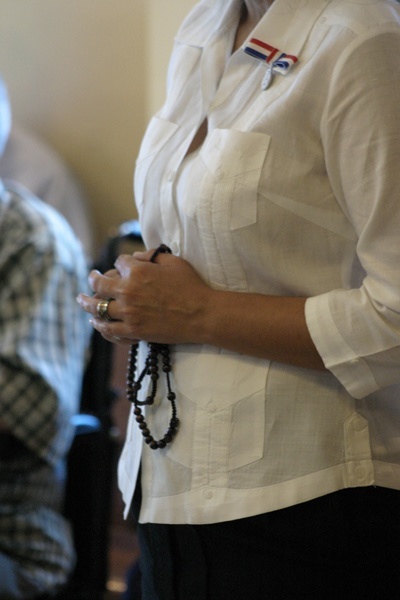
Photographer: ANA RODRIGUEZ-SOTO | FC
A member of the Archicofradia (Guild) of Our Lady of Charity holds rosary beads while providing an honor guard for Bishop Agustin Roman's body.
“For us he was the image of priesthood. He was the epitome of holiness. He was what all of us aspired to be,” Father Alvarez said.
He would have made a great husband, too, said his secretary for the past six years, Alina Novaro. She actually met the future bishop when he was first assigned to the shrine as a priest. She was the sacristan for the chapel that existed on the site before the shrine was built.
Since her own retirement, Novaro had been answering the bishop’s emails, typing up his frequent columns to newspapers and keeping track of all the ordination anniversaries of the priests of the archdiocese — for every year without fail, Bishop Román would send a congratulatory note to each and every one of them.
And every Monday when she came to work, Novaro would find a vase of flowers on her desk — cut and arranged by the bishop himself. With those flowers and daily doses of “500 thank you’s,” or the promise of a “café con leche” if she could decipher his scribblings, Bishop Román let her know he appreciated her work.
“He was a gentleman,” Novaro said, adding that she would always tell him: “If you had gotten married, you would have been the ideal husband.”
Lorenzo Ferrer first met the future bishop when he was five years old. “When I first entered school, he entered the seminary,” said Ferrer, noting that his school was across the street from San Lorenzo Magno, and the seminarians served as its teachers. When the future bishop returned from higher studies in Canada to be ordained in 1959, Ferrer was selected to serve at the altar. They met again when Ferrer and his wife Noelia arrived in Miami in 1979.
“He was a bishop. But when I saw him, he was the same; the same haircut; the same man of God, profound, joyful. And I hugged him as if I had never stopped seeing him.”
In September 2011, Ferrer and his wife returned to Cuba to report for Radio Paz, the archdiocesan station, on the celebration at El Cobre marking the opening of the Marian year — the 400th anniversary of the discovery of the image of Our Lady of Charity on the Bay of Nipe.
Radio Paz had no budget for their trip so Bishop Román paid for it, Ferrer said. Not with the shrine’s money, but with “his own Social Security money.”
“He was a man of God. From the time he woke up to the time he went to bed, his was a constant relationship with God,” Ferrer said. “My only regret is that I never persuaded him to return to Cuba.”
And yet, he added, “He had a role on this side. There was a very wounded community here that he represented.”
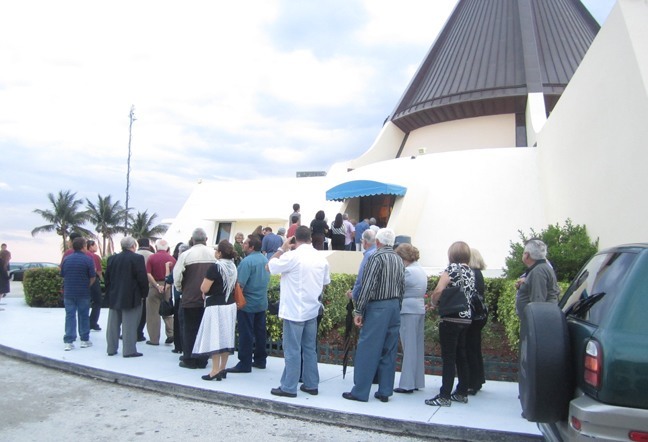
Photographer: ARACELI CANTERO | FC
People line up outside the Shrine of Our Lady of Charity to view the body of Bishop Agustin Roman. Sometimes they stood in line for 30 minutes or longer. The crowds continued to come, day and night, for the nearly two days that his body lay in state.

